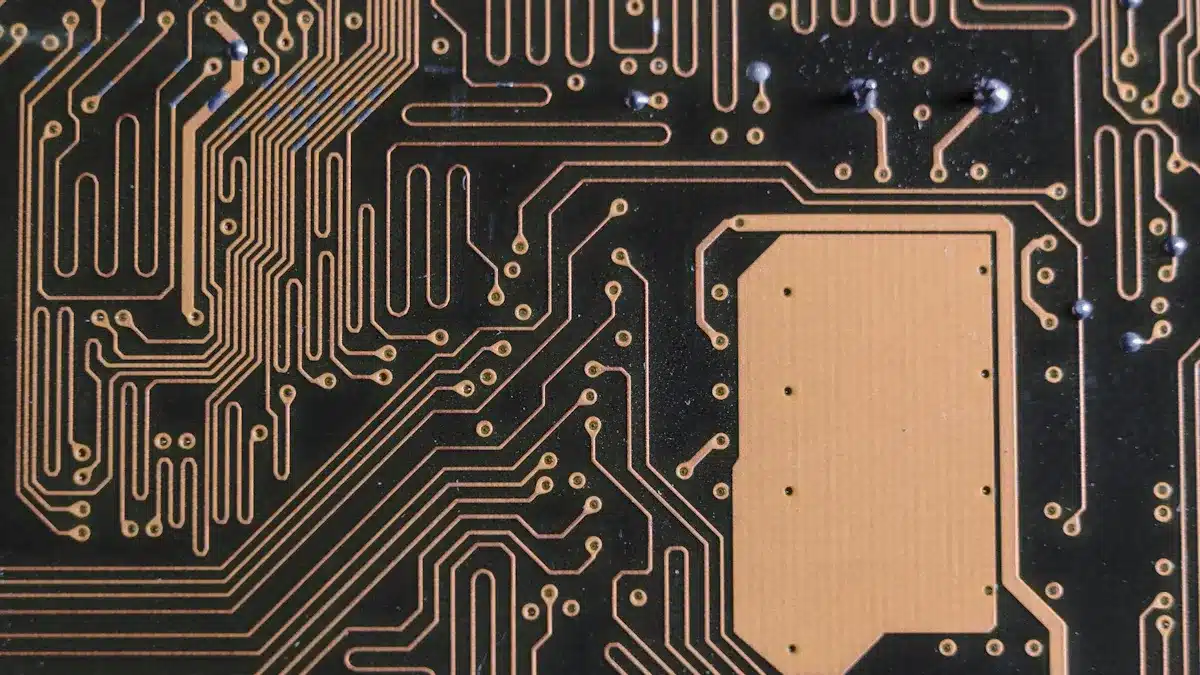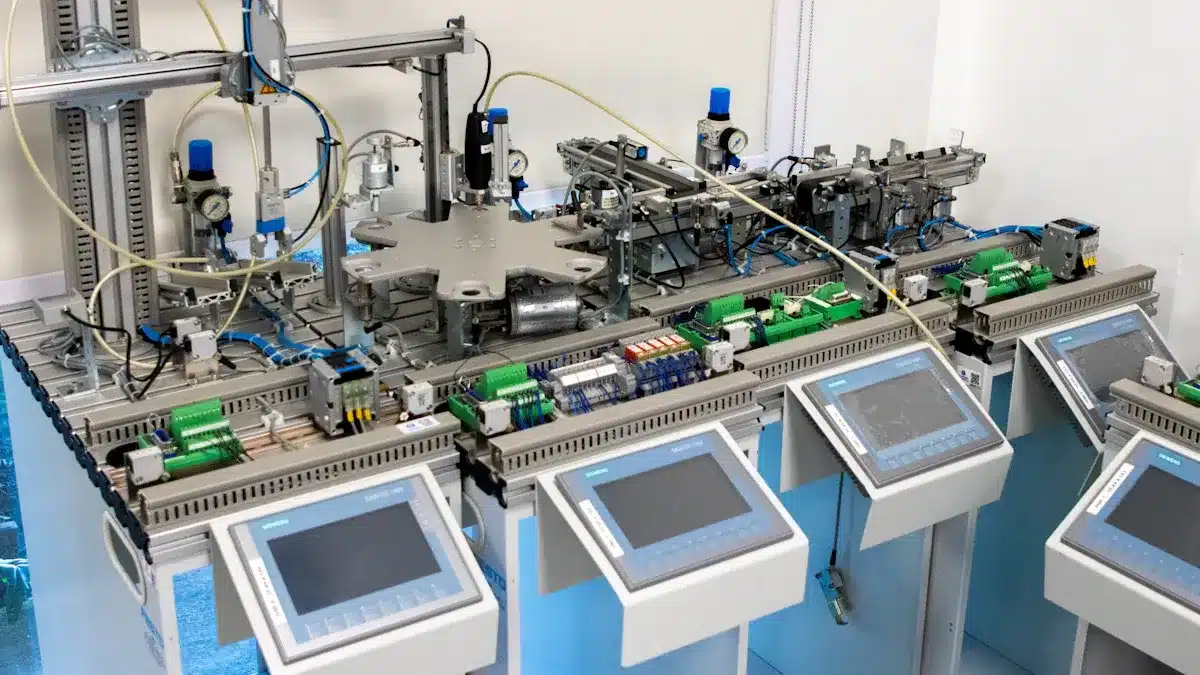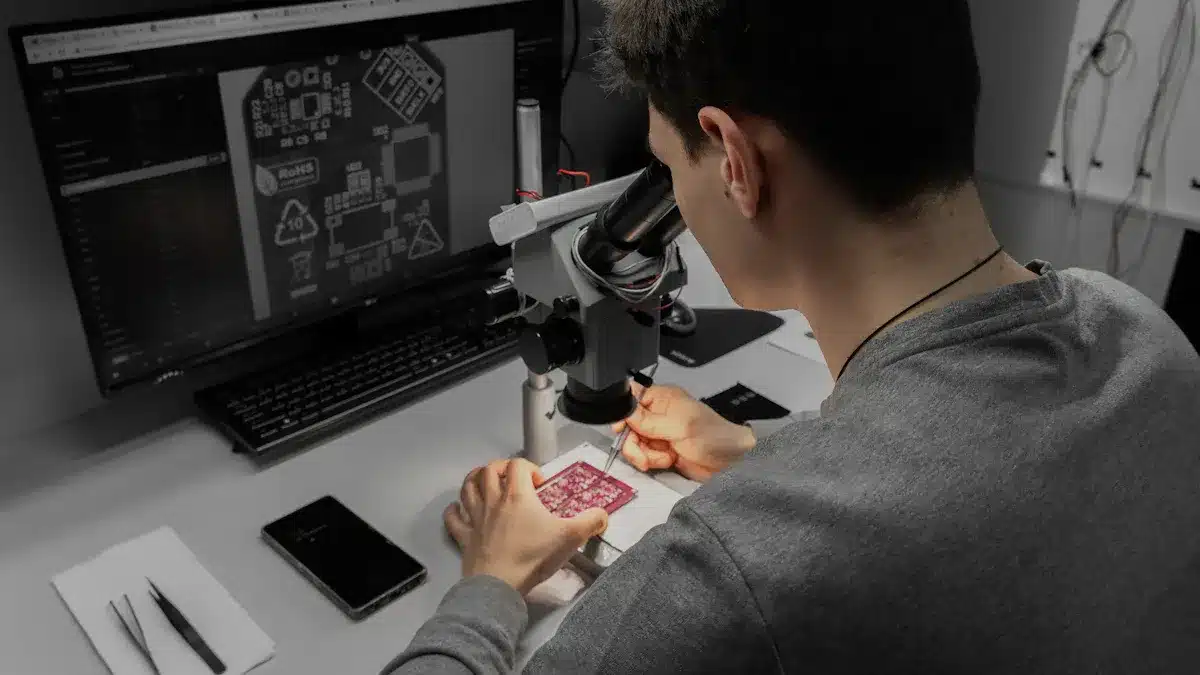
Printed circuit boards (PCBs) are very important in today’s electronics. As technology gets better, more people want good PCB assembly and manufacturing. In 2023, the global market for this industry was about $90 billion. It is expected to grow to $145 billion by 2032. This growth is because more people need electronic devices like smartphones and IoT gadgets. New tools like augmented reality (AR) are changing how manufacturers do assembly. They help make things more precise and productive.
Key Takeaways
PCB manufacturing makes the basic circuit board. It shapes materials and adds copper paths. This forms the base for electronic devices.
PCB assembly puts electronic parts on the bare board. It connects them with solder to create a working circuit.
Quality control is very important in both manufacturing and assembly. It helps find problems early and ensures high-quality PCBs.
Manual assembly works well for small runs and prototypes. Automated assembly is faster and more consistent for large production.
When choosing a PCB service provider, think about their experience, quality control, technology, cost, and communication.
PCB MANUFACTURING OVERVIEW

PCB manufacturing is about making printed circuit boards. These boards are very important for electronic devices. This process changes raw materials into working circuit boards. These boards power everything from smartphones to medical devices. Knowing how PCB manufacturing works is important for anyone in electronics. It affects how well the final product works and how reliable it is.
PCB Manufacturing Process
The PCB manufacturing process has several important steps. Each step is key to making sure the final product is good quality and works well. Here are the main steps involved:
Material Selection: Pick the right substrate materials like FR-4, polyimide, or aluminum based on the PCB type.
Printing the PCB Layers: Put photosensitive film on and use photoengraving to print circuit patterns on the substrate.
Etching: Use chemical etchants to remove unwanted copper and leave the right copper traces.
Drilling: Use automated drilling machines to make holes for component leads and vias.
Plating and Coating: Improve conductivity and resist corrosion by plating, then apply a solder mask to stop solder bridging.
Surface Finish: Use finishes like HASL, ENIG, or OSP to help soldering and protect copper pads.
Assembly: Attach components using Through-Hole Technology (THT) or Surface Mount Technology (SMT).
Testing: Do visual, functional, and automated tests to check PCB functionality and reliability.
Quality Assurance: Make sure to follow IPC standards and do environmental testing to meet quality and reliability needs.
Delivery: Carefully package and ship the finished PCBs to avoid damage.
Key Stages in PCB Manufacture
The PCB fabrication process has several key stages that help make high-quality circuit boards. These stages include:
Designing the PCB Layout: Use special software to create a digital version of the circuit.
Printing the PCB Design: Physically transfer the layout onto a copper board.
Etching the Copper Board: Remove extra copper to leave the needed circuit traces.
Drilling Holes: Make holes for inserting components and plate these holes with copper for conductivity.
Applying a Solder Mask: Protect copper traces and stop solder bridges.
Silkscreen Printing: Add text, labels, and graphics for assembly and identification.
Electrical Testing and Inspection: Check for continuity, find shorts or opens, and ensure proper functionality.
Each of these stages needs precision and careful attention. A small mistake can cause big problems in the final product.
Quality Control in PCB Manufacturing
Quality control is very important in PCB manufacturing. It makes sure the final product meets design specifications and works reliably. Here are some good quality control methods:
Electrical Testing and Continuity Checks: Make sure there are no shorts or open circuits and check signal integrity.
Thermal Cycling and Stress Testing: Test durability and reliability by simulating extreme environmental conditions.
Soldering Quality Control: Keep strong, defect-free solder joints through temperature control and inspection.
Component Placement and Orientation Verification: Use automated machines and visual checks to stop short circuits and device problems.
Functional Testing and Burn-In Testing: Simulate real operating conditions to find hidden defects and ensure long-term reliability.
By using these quality control methods, manufacturers can find defects early and keep high standards during the PCB fabrication process.
PCB ASSEMBLY OVERVIEW

PCB assembly is when electronic parts are soldered onto a bare PCB. This makes a working circuit board. This step is very important in electronics. It creates the electrical connections between parts. Good PCB assembly helps devices work well and be reliable. It allows more functions in a small space, which is important for small electronics. Using machines in PCB assembly makes production faster and cheaper. New technology keeps improving this area in the electronics world.
PCB Assembly Process
The PCB assembly process has several key steps. These steps change a bare PCB into a working device. Here are the main steps:
Design Review (DFM Check): Check the PCB design to fix any problems.
Solder Paste Printing: Put solder paste on PCB pads using stencils.
Pick and Place: Use machines to put surface mount parts on the solder paste.
Reflow Soldering: Heat the board to melt the solder paste and hold the parts.
Inspection: Do visual and machine checks to ensure good soldering.
Through-Hole Component Insertion: Put through-hole parts in by hand or machine.
Wave Soldering: For through-hole parts, move the PCB over hot solder to attach pins.
Cleaning: Wash off flux and dirt with deionized water.
Final Inspection and Functional Testing: Check that the assembled PCB meets electrical and quality standards before packaging.
This process makes sure that PCB assembly is effective and meets the needed requirements.
Manual vs. Automated PCB Assembly
For PCB assembly, you can choose manual or automated methods. Each has its pros and cons.
Aspect | Manual PCB Assembly | Automated PCB Assembly |
|---|---|---|
Flexibility | Very flexible; easy to change designs without stopping work. | Less flexible; hard to change once machines are set up, which can cause delays. |
Cost | Lower initial costs; good for small production runs. | Higher initial investment in machines; better for large production runs. |
Speed | Slower; needs more labor and time. | Much faster; machines quickly place and solder parts, great for big orders. |
Accuracy | Can have human errors; quality depends on worker skill. | Very precise; machines ensure parts are placed and soldered correctly. |
Consistency | Quality can vary due to human factors; depends on worker skill. | Consistent quality for all units; great for industries needing uniformity. |
Manual assembly is often better for small production runs, prototypes, or special part placements. Automated assembly is best for large production, where speed and consistency matter.
Quality Control in PCB Assembly
Quality control in PCB assembly is very important. It ensures the final product works well and is reliable. Here are some common methods used:
Solder Paste Inspection (SPI): Checks that solder paste is applied correctly before placing parts, preventing bad solder joints.
Automated Optical Inspection (AOI): Uses cameras to find missing parts, wrong placements, and solder problems.
Functional Circuit Testing (FCT): Tests the PCB under real-world conditions to check if it works.
In-Circuit Testing (ICT): Tests each circuit and part electrically with special tools.
Burn-In Testing: Exposes boards to tough conditions to find early failures.
These quality control methods help catch problems early and keep high standards during PCB assembly. Reports show that the average defect rate in PCB assembly can be about 0.08% to 0.97%. Using good quality control can lower these defects, making sure your products meet high standards.
By learning about the PCB assembly process, the differences between manual and automated methods, and the importance of quality control, you can make smart choices that improve the reliability and performance of your electronic devices.
COMPARING PCB ASSEMBLY AND MANUFACTURING
When you compare PCB assembly and manufacturing, you see two different steps. Both are very important for making electronic devices. Knowing how they differ helps you understand how they work together to make good products.
Differences in Processes
PCB manufacturing is about making the bare circuit board. This process has several main steps. These include preparing the substrate, adding copper, etching, and drilling. The goal is to create a working base without any parts. On the other hand, PCB assembly takes this bare board and adds electronic parts to make it work. This includes getting components, applying solder paste, placing parts carefully, soldering, and checking everything.
Here’s a quick comparison of the two processes:
Aspect | PCB Manufacturing | PCB Assembly |
|---|---|---|
Definition | Making the bare circuit board | Adding and soldering parts onto the PCB |
Key Processes | Substrate prep, copper lamination, etching | Getting parts, applying solder paste, placing parts |
Timeline | Usually 3-7 days | Similar time but depends on part availability |
Skill Requirements | Knowledge of materials and precision | Understanding circuit design and soldering skills |
Cost Factors | Labor and costs of getting components |
Interdependencies and Turnkey Services
PCB assembly and manufacturing are closely connected. You cannot do assembly without first finishing manufacturing. Many companies offer turnkey services that combine both steps. This means they take care of everything from making the PCB to getting parts and assembling them.
Using a turnkey service makes your project easier. You only talk to one provider, which cuts down on miscommunication and delays. The provider handles everything, making sure that manufacturing meets assembly needs. This teamwork leads to faster production times and can lower costs.
CHOOSING A PCB SERVICE PROVIDER
Picking the right PCB service provider is very important for your project’s success. You need a partner who can give you high-quality PCBs that match your needs. Here are some important things to think about when making your choice:
Key Factors for Selection
Expertise and Experience: Find manufacturers with a good history in PCB design and assembly. Their skills can help you avoid common mistakes.
PCB Assembly Capabilities: Make sure the provider has modern equipment and skilled workers. This will improve the quality of your assembly.
Prototype PCB Assembly Services: If you are just starting, pick a provider that offers prototype services. This lets you test and improve your design before making a lot of them.
Quality Control Measures: Check the quality processes and certifications the provider has. Good quality control makes sure you get products without defects.
Manufacturing Facilities and Technology: Modern facilities can boost both quality and efficiency. See if the provider uses the latest technology.
Customization Options: Your project might have special design needs. Make sure the provider can meet these requirements.
Scalability and Production Volume: Choose a provider that can grow from small prototypes to large production. This flexibility is important as your project expands.
Cost and Pricing Structure: While cost matters, balance it with quality and delivery time. The cheapest option might lead to poor products, causing higher costs later.
Lead Time and Delivery: Reliable and quick delivery keeps your project on track. Check the provider’s history for meeting deadlines.
Customer Support and Communication: Good communication is key. You want a provider who helps you throughout the process.
By thinking about these factors, you can make a smart choice that fits your project goals.
Importance of Quality Control
Quality control is very important when choosing a PCB service provider. It makes sure your PCB assemblies are free of defects and meet all requirements. Here are some reasons why quality control is essential:
Defect Prevention: Strong quality control leads to better results. This lowers the chance of defects in your final product.
Recognized Standards: Look for providers that follow quality standards like IPC-A-610 and ISO 9001. These certifications show a commitment to quality management.
Testing Competency: A provider should have different testing systems and skilled engineers. This ensures your PCBs work reliably and meet quality standards.
Risk Reduction: Choosing a provider with strong quality control lowers risks. It helps your project succeed and brings your products to market faster.
Knowing about PCB manufacturing and assembly is very important for anyone working with electronics. You learn how raw materials change into working devices. This helps you create PCBs that fit with new technologies and ways of making them.
Here are some main points from comparing PCB manufacturing and assembly:
Aspect | PCB Manufacturing | PCB Assembly |
|---|---|---|
Primary Focus | Changing raw materials into a structured PCB with exact electrical paths | Adding electronic parts onto the PCB and making electrical connections |
Key Activities | Making sure designs are accurate, using good fabrication methods, and checking quality of the board | Placing components, soldering them, and testing for functionality |
Quality Control Emphasis | Checking physical features like trace width, layer alignment, and solder mask | Testing the assembled PCB to ensure it works correctly and has strong solder joints |
Contribution to Final Product | Sets up the right PCB structure for good assembly | Turns the PCB into a working electronic device by adding components |
By understanding these steps, you can work better with manufacturers and lower problems after production. This knowledge helps create better quality, cost-effective, and reliable electronic products. 🌟
FAQ
What is the difference between PCB manufacturing and assembly?
PCB manufacturing makes the bare circuit board. Assembly adds electronic parts to that board. Manufacturing focuses on building the board, while assembly makes sure it works as a complete device.
How long does the PCB manufacturing process take?
The PCB manufacturing process usually takes 3 to 7 days. Things like how complex the design is, material availability, and how many boards are made can change this time.
What are the common materials used in PCB manufacturing?
Common materials are FR-4, polyimide, and aluminum. These materials give the right electrical insulation and heat resistance for different uses.
Why is quality control important in PCB assembly?
Quality control makes sure that assembled PCBs work correctly and meet the needed standards. It helps find problems early, which lowers the chance of failures in the final product.
Can I get a prototype PCB before full production?
Yes, many PCB service providers have prototype services. This lets you test and improve your design before making a lot of them, which leads to better results.
See Also
Complete Overview Of The PCBA Production Process
Exploring The Methods Behind PCBA Manufacturing And Assembly
Detailed Walkthrough Of Each PCBA Manufacturing Stage
Effective Strategies To Improve PCB Assembly Productivity
Ten Professional Recommendations For Cost-Effective PCBA Assembly